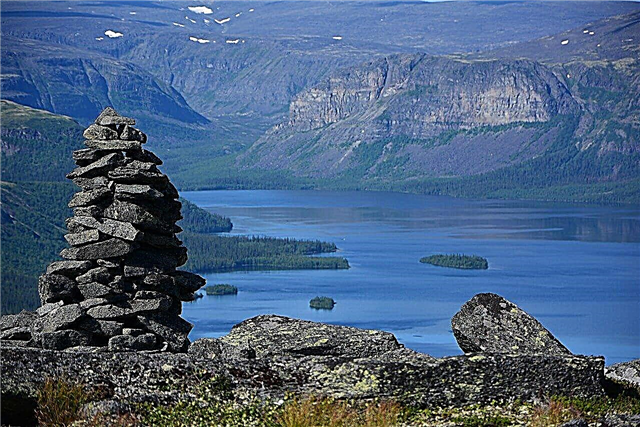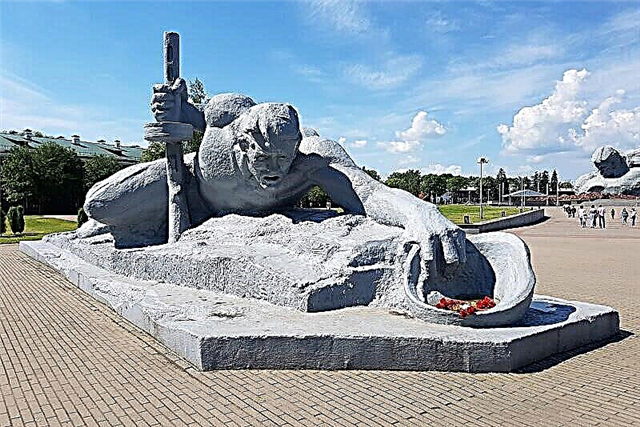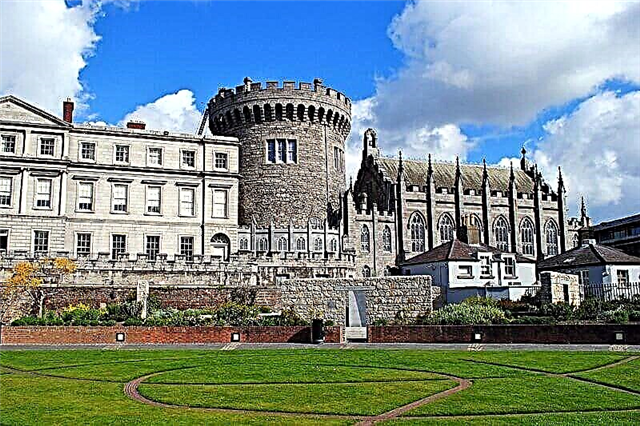Ireland's eventful history has left countless attractions. Castles occupy a special place among these memorable places. Some have now become hotels or museums. Some are forgotten and destroyed. Descendants of glorious Irish families still live somewhere. Each castle has its own mysterious story, shrouded in rumors and mysticism, associated with secrets and ghosts.
Most of the castles begin their history from the XI-XII centuries, from the Celtic times. Initially, the fortresses were built exclusively for fortification and defensive purposes. They were built from wood and earth, later - from stone. Something was being rebuilt, new buildings appeared in new styles. They began to pay more attention to the castle landscape. The issue of restoration and reconstruction of medieval castles is still relevant in Ireland.
The most interesting medieval castles and fortresses
List, photos with names and descriptions of historical castles.
Dublin Castle
Castle in the capital of Ireland. The construction of the castle was initiated by the English king John Lackland in 1204. In the course of history, the castle was destroyed and rebuilt again. Most of the existing buildings date back to the 18th century. Built as a powerful defensive structure with high walls and watchtowers, the castle has never been sieged. It was the residence of the king, the seat of the court and parliament. Renovated and accessible to tourists on days when there are no official ceremonies.

Dolki
Castle in the suburb of Dublin, the small resort of Dolki. Such fortifications were built by the Normans in the XIV century to store goods. The local name is Goat Castle. Now in this castle there is a unique Gallery of Writers, including Bernard Shaw, Emma Donoghue, Maeve Binchy. Interactive panels with portraits and quotes of more than forty writers of the country are combined into the wall map "The Writers' Trail".

Ashford
County Mayo Castle. Built in 1228 on the site of an Irish monastery. Located on the banks of the Kong River and Lough Corrib Lake. During its existence, it has repeatedly changed owners. Currently, the castle houses one of the best hotels in Ireland. This opinion was shared by the British King George V, John Lennon, Ronald Reagan, Brad Pitt, who at one time stayed at this place.

Dromoland
Castle in the western part of Ireland in County Clare. Built in 1475. There is a man-made park to the south of the castle. Most of its history has belonged to the O'Brien clan. After the change of ownership in 1862, the castle was reconstructed and rebuilt. Currently, there is a high-class hotel here. Among its guests were John Travolta, Jack Nicholson, Bill Clinton, Muhammad Ali, George W. Bush.

Rock of Cashel
Castle in County South Tipperary. For several centuries, the Rock of Cashel was the seat of the Irish kings. In this place Saint Patrick lived and preached. This is one of the shrines of the Irish lands. The construction of the fortress on the Rock began in the 4th century. Today the castle complex is surrounded by a stone wall. Work on the restoration of the shrines behind this wall on the Rock of Cashel is still underway. The castle is open for visits.

Blarney
Founded by Dermot McCarthy in County Cork in the middle of the 15th century. The current building is the third in a row on these lands. Several attempts by Elizabeth I to take possession of the castle went down in history, but the queen did not achieve her goal. Blarney's main attraction is the Stone of Eloquence. It is part of a sacred relic and is built into the wall. Tourists are offered to kiss him to gain the gift of eloquence.

Trim
County Meath castle on the banks of the Boyne. Known as the filming location of the movie "Braveheart". It is considered one of the largest Norman fortifications. The construction of the massive and majestic fortress began in 1172. In the course of history, it was rebuilt, destroyed, changed owners. In 1993 it was transferred to the state. Since that time, the reconstruction and restoration of the castle began. Opened to the public in 2000.

Lip
Castle in County Offaly. Founded at the end of the 15th century. It is considered one of the most mystical and mysterious castles in Ireland. Bloody clan showdowns between owners and heirs left many traces in the castle. During restoration in 1920, a large number of bones were found in the dungeons. Locals also talk about the large number of ghosts that inhabit the castle. It is difficult to verify this. Currently Lip Castle is a private property.

Malahide
Castle in the outskirts of Dublin. Founded in 1185. Almost all of its history belonged to the Talbot family. One of the few castles that has survived to our time in its original form. Now there is a museum with old interiors. Around the castle there is a large well-groomed park and endless lawns. The rich history, the tragedies that the castle went through, gave rise to many legends about ghosts. It is believed that there are five of them in this castle.

Kilkenny
Castle on the banks of the Nor river. Founded in the XII century. It has been the property of the Butler family for nearly six centuries. During its existence, it was repeatedly rebuilt. Combines various architectural styles. The castle is surrounded by a garden with terraces and ancient fountains. The halls of the castle are luxuriously decorated. It hosted parliamentary sessions and important historical events. Now luxurious wedding ceremonies take place here.

Care
A castle on an island on the Cher River in southern Ireland in County Tipperary. Built in 1142. One of the largest and best preserved castles. Throughout history, it has never been destroyed, because in all wars it surrendered without a fight. At the highest part of the island is the oldest part of the castle with a courtyard and massive towers. On St. Patrick's Day, it is illuminated with green lights. Open to visitors every day.

Glenway
Castle in County Donegal in the north of the country. One of the youngest in Ireland. Built in 1873 among mountains, forests and lakes. Glenway Castle is a four-story structure with a circular tower. According to the founder's plan, the beauty of the royal Balmoral was to be surpassed. A garden of unique tree species is planted around the castle. Currently owned by Ireland, available to tourists from January to December.

Bunratty
Castle in County Clare. Built in 1425. Bunratty is a classic medieval fortress with a park at the foot of it. Repeatedly destroyed, changed owners. The last reconstruction of the citadel was completed in 1954. It is currently open to tourists all year round. Inside the castle there are authentic interiors, original furniture from the Middle Ages and tapestries. Famous for its medieval banquets.

Charleville
One of the most popular architectural landmarks in the country. Located near the town of Tallmore. The exact date of construction is unknown, changes were made to the design until the 19th century. At the same time, the dominant style - neo-Gothic - remained unchanged. Since the XX century, the castle has been accessible to tourists. The interior furnishings are not inferior to the exterior, especially the decorative ceilings.

Blackrock
Located near the town of Krok. It was erected by the personal order of Elizabeth I in the 16th century. Was needed to contain pirates and gangs roaming around the area. It was also used for receptions and other social events. Blackrore's architectural style changed to neo-Gothic in the 19th century. Purchased by a private company since 2001. After renovation, offices, a restaurant and an observatory were located inside.

Birr
Castle in County Offaly. The first mentions date back to 1170. The modern appearance of the castle has been formed since 1620, when a new building was erected. Later, during the reconstruction at the beginning of the 19th century, the height of the castle was increased, it acquired a Gothic look.At the same time, a powerful telescope was installed here, the largest in the world at that time. Privately owned. The castle grounds and gardens are available for visiting.

Ross
County Kerry Castle on the shores of Loch Lane in Killarney National Park. Built at the end of the 15th century. The castle itself is a classic Irish fortress with round corner towers and thick walls. The residential part is also a tower, but more powerful. Now the castle has been restored and is open all year round. Legends about the owner of the castle, possessed by evil spirits, are told only in group excursions. Individual visits are not permitted.

Huntington
Castle in County Carlow in the south of Ireland. Founded in the 15th century. It was originally built as a strategic defensive garrison. Later it became a family estate. Luxurious man-made gardens with exotic trees, a yew alley and artificial ponds have survived to this day around the castle. One of the few castles that in the entire history of its existence belonged to the same family. The descendants of the Esmond baronial family still live here.

Kilki
Castle in County Kildare. Built in 1180 in the style of Norman castles - a monumental tower on a hill, surrounded by a palisade. At one time, the castle was a family residence, was rented out, was repeatedly plundered and restored. In the 60s of the XX century it functioned as a hotel. Parties, banquets, and wedding ceremonies were held here. Closed after the financial crisis in 2008. But it can be bought or rented.

King John's Castle
The castle is located in the city of Limerick on the King's Island. Built at the beginning of the 13th century by order of King John Lackland. High solid walls with loopholes, the towers are still well preserved. This is one of the most impregnable fortresses in history in the west of Ireland. Currently, it houses a museum of weapons from ancient times. Part of the castle is still undergoing archaeological excavations.

Clifden
Castle in County Galway. Built in 1818. The castle is made in neo-gothic style overlooking Clifden Bay. Several decades after the completion of the construction were successful for the family of the owners and the castle itself. After the Great Famine of 1845, the sad part of this story begins. The owners went bankrupt, and the adjacent lands began to be divided. Since 1894, the castle has been abandoned and gradually fell into decay.

Donegal
Castle in County Donegal in the northwest of Ireland. Built in the 15th century on the cliff of the Eske River. The castle is small, with elements of the Jacobin style. It lay in ruins for more than two centuries. In the 1990s, the castle was renovated, taking into account the style and techniques of the 15th century. We used local natural materials - limestone and sandstone. The castle is currently open to the public. It often hosts cultural events.

Dunguire
Castle in County Galway near the town of Kinvara. Built in 1520. I was in a rather neglected state. The reconstruction and restoration of the castle at the beginning of the 20th century was taken up by a new owner. The restoration was completed in 1954 by another owner. It is now one of the most popular castles in Ireland. In the summer months, fancy-dress medieval banquets are held here, Irish music sounds.

Carlow
Castle in Carlow County. The first mentions date back to 1231. It was erected on a high hill on the banks of the Barow River. It was one of the first classical dungeons - a rectangular stone structure of three floors with rounded towers at the corners. An unsuccessful reconstruction of the castle by one of the owners in 1814 led to its complete destruction. Only the façade of the western wall and two round towers have survived to this day.

Enniscorthy
Castle in County Wexford. Built in 1190. It is a massive structure with classic circular cogwheels around the perimeter. Over the years, it was a defensive structure, a prison, a private residence. In 1951 it was transferred to the state. It currently houses the Wexford County Museum. The last reconstruction of the castle was carried out in 2006. A tour of the castle, including the observation deck on the roof, is now possible even for wheelchair users.

Lismore
Castle in County Waterford. One of the most luxurious castles in Ireland. It is surrounded by a garden with terraces and yew avenues, which were laid during the construction of the castle. Reconstructed and equipped with all comforts: from modern bathrooms to wi-fi in all areas. It is privately owned. Popular as a venue for wedding ceremonies. Open to the public from March to September.

Athenray
Belongs to County Galway. Built in 1240. Subsequently, the city of the same name appeared around. Only the central tower and part of the wall remained from the castle. The interior has been restored in the style of minimalism. A wooden staircase leads to the second and third floors. Moreover, the latter has no windows, which is why it is dark and the air is always humid. Information signs are posted on the territory of the Athenry.

Ballicarbury
It stands on a hill a few kilometers from the town of Kersiwyn. The ruins that have survived to this day are dated to the 16th century. The castle walls and part of the fence are overgrown with moss and ivy. Although the stairs that lead to the conditional second floor are in place, you cannot climb them due to safety precautions. There are several legends associated with Ballicarbury. One of them concerns a secret underground tunnel. But it was never found.

Clononi
The castle was founded before the beginning of the 16th century. Located in County Offaly. The central building is a 15 meter high tower. It is surrounded by gardens and a moat. Near the walls was discovered the grave of the Boleyn sisters - relatives of Elizabeth I. Klononi is recognized as a national monument of the country. The castle has been restored just enough for tourists to visit it safely. There is no work schedule, entrance to the territory is free.

Castle Do
Built near the village of Krisloh in the 16th century. It stands on a small peninsula, partially surrounded by water and a moat. The castle was one of the important locations during the Three Kingdoms War. The owners of these lands changed frequently. Do is considered the best-preserved fortification of its time in the region. Included in the list of national monuments. Tourists are told about the ghost of the countess who committed suicide because of unrequited love.












